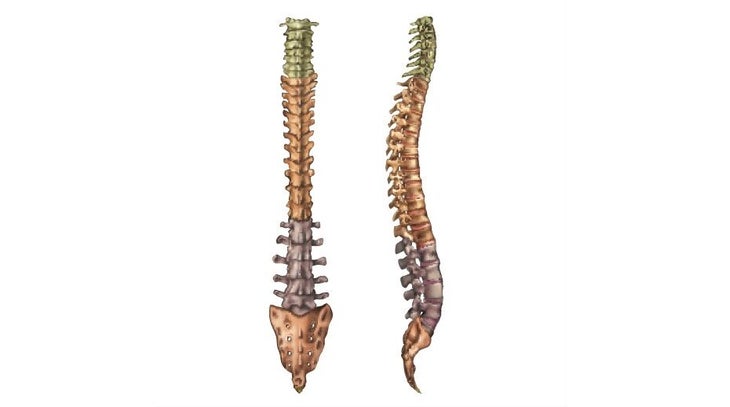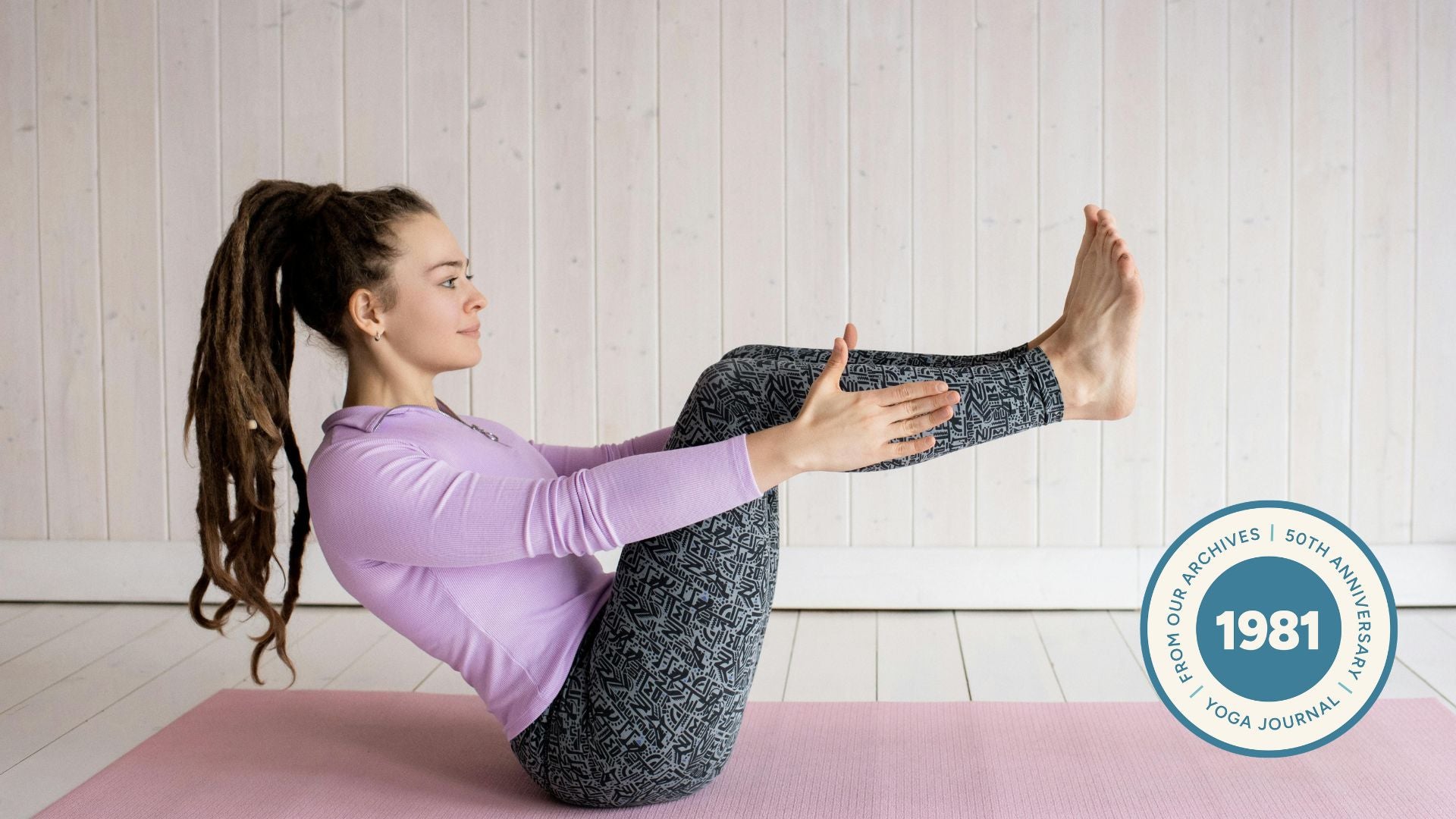“], “filter”: { “nextExceptions”: “img, blockquote, div”, “nextContainsExceptions”: “img, blockquote, a.btn, a.o-button”} }”>
Heading out the door? Read this article on the new Outside+ app available now on iOS devices for members!
>”,”name”:”in-content-cta”,”type”:”link”}}”>Download the app.
In case you haven’t thought about your spine lately, it’s literally an engineering marvel. It’s a vertical stack of bones, fit together like puzzle pieces, that protects your precious spinal cord. And sandwiched between each vertebrae are elastic discs that enable you to move in almost any direction. When you understand how essential the spine is to your movement, it’s no surprise that a large portion of the yoga cues you hear in class relate to your back in some way.
But that doesn’t mean you understand what they mean. Since these yoga cues relate to a part of the body that is out of sight, it can feel completely unclear as to what, exactly, you’re being asked to do. The following explanations of common yoga cues help you understand what they mean and when they’re relevant on the mat.
5 Yoga Cues for the Back—And What They Actually Mean
Flat Back
Your spine, of course, is not flat. It’s a sweeping S-shape with natural backbends, known as lordosis, in your neck and lumbar spine and forward bends, called kyphosis, in your thoracic spine and sacrum. These curves help the column of vertebrae absorb shock and rebound upright, a little like a spring.

What It Means: The cue “flat back,” although not anatomically accurate, can be helpful in situations in which gravity pulls those natural curves out of whack. This typically happens when your spine is horizontal and gravity draws your head, shoulders, and/or belly toward the ground, exaggerating some or all of the existing curves in your spine.
Hearing the cue “flat back” can help you become aware when the contours of your spine have shifted so you can make the necessary adjustments to come back to neutral. That usually means engaging the abdominal muscles, drawing your shoulders back, and reaching through the top of the head. The words “flat back” cue these instinctive actions in a way that “neutral spine” doesn’t.
When This Cue Helps: Tabletop, Plank (Phalakasana), Standing Half Lift (Ardha Uttanasana), and Warrior 3 (Virabhadrasana III).
Lengthen Your Spine
The cue “lengthen your spine,” admittedly, lacks specificity. Backbends lengthen the front of the spine. Forward folds lengthen the back of the spine. Side bends lengthen one side of the spine.
What It Means: Since this phrase is typically mentioned by teachers when you’re sitting or standing upright, you can surmise that it means to be taller. The subtle action of lifting each vertebra off the one beneath it recruits the deep core muscle transverse abdominis, which wraps around your waist like a corset. To visualize how engaging that muscle helps you feel taller, imagine lengthening a wrinkled toothpaste tube by squeezing its center or elongating a circle into an oval by cinching it in at its center.
You might also be familiar with variations of this cue, such as “reach through your crown,” “stand/sit tall,” or “stack your spine.”
When This Cue Helps: Whether as a stand-alone instruction in a pose or to set your alignment before you transition into twisting or hinging forward, the cue is most relevant in poses such as Mountain (Tadasana), Warrior 2 (Virabhadrasana II), Hero (Virasana), and Staff Pose (Dandasana).
Navel to Spine
Although sometimes offered as a general suggestion for core engagement, the cue to draw your “navel to spine” is most relevant in rounded back poses that work against gravity.
Why It Works: We know the thoracic spine rounds naturally, and the natural tendency of the lumbar spine is to round easily in certain positions, such as sitting. However, rounding the low back when it’s horizontal, and the weight of the belly is subject to gravity, requires deliberate muscle engagement.
Since your abdominal organs are in the way, you can’t literally draw your navel to your spine, but the idea of pulling your belly in triggers your “six-pack” muscle, the rectus abdominis, which draws your low ribs toward your pubic bone to help round your low back. You might also have heard variations on this, including the yoga cues “scoop your belly,” “hollow your belly,” “draw your belly in and up,” or even “dome your low back.”
When This Cue Helps: Poses that ask you to resist gravity, such as Cat (Marjariasana), taking your knee to nose in Plank, or arm balances such as Crow or Crane (Bakasana).
C-Curve Your Spine
The spine’s natural shape is much closer to a S-shape than a C-curve, so this cue is not intended to be taken literally. Rather, it’s a visualization, usually offered in yoga backbends.
Why It Works: Before you can understand the benefit of this cue, it helps to recall that in addition to the spine’s natural curves, its regions have different bony shapes which affect your capacity for movement. The mid back or thoracic vertebrae have long downward bony projections at their rear. This, along with their attachments to the ribcage at the front, limits the capacity for movement in backbends.
In contrast, the low back or lumbar vertebrae have much shorter, more horizontal bony projections at their rear, and no limiting structure at their front, giving this region much greater capacity for backbends. This anatomy creates a tendency to “hinge” at the low back in deep backbends, especially those assisted by gravity.
Although the mid back will never move deeply into backbends, the cue “C-curve the spine” encourages smoothing that lumbar hinge into a broader curve that intensifies the stretch along the chest and hip flexor muscles. It does so by engaging the rectus abdominis muscle to limit the contribution of the low back.
You may also have heard this cued as “knit your front ribs in and down,” “inflate your kidneys,” “draw your public bone toward your navel,” “lift your lower abdomen,” or “lengthen your sacrum.”
Poses Where You Hear It: Think Camel Pose (Ustrasana) or poses in which the hands and feet are fixed in place, such as Bow Pose (Dhanurasana) and Wheel Pose (Urdhva Dhanurasana).
Twist From Your Mid Back
Although the lumbar spine is great at backbending, it has very limited ability to twist. (Most anatomy textbooks note that the normal rotational capacity for this region is as little as five degrees in either direction.)
Why It Works: It’s almost impossible to isolate any movement to any single part of the spine. But the cue to “twist from the mid back” (meaning your sternum or chest area) brings your attention to your chest or mid back instead of your low back. This helps you focus on rotating in areas better suited to the movement.
Because the low back is a key transition zone between upper and lower body, it’s easy to push the lumbar spine past its natural range of motion. This cue helps prevent that.
When This Cue Helps: The cue is especially important in bound twists where it would be possible to use leverage to intensify the twist past the lower back’s capacity. Picture Revolved Chair Pose (Parivrtta Utkatasana) and Revolved Lunge (Parivrtta Anjaneyasana) in which you hook your elbow over your knee. Also, Revolved Side Angle (Parivrtta Parsvakonasana) or Revolved Triangle (Parivrtta Trikonasana) with the bottom hand braced against the outer front foot.







